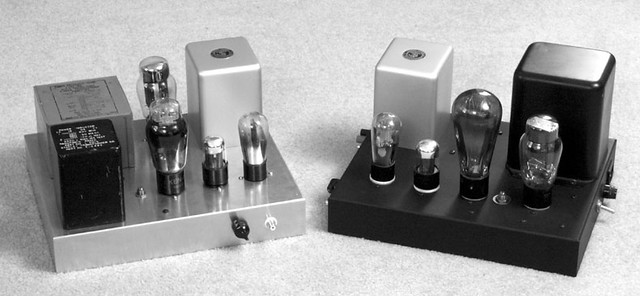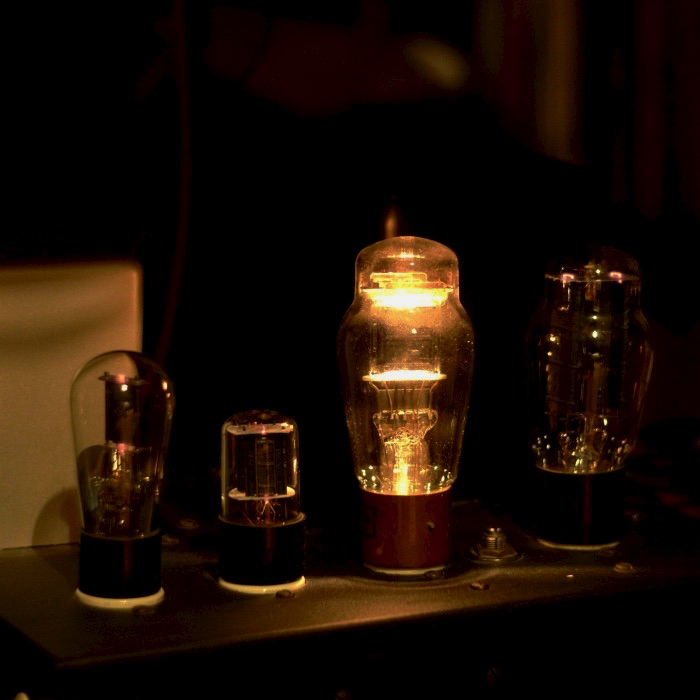From Western Electric to
Altec
The original Western Electric 8" 755A
driver along with the 10" 756A and 12" 728B and 754A were marketed a
couple of years after World War II. According to Walt Bender, former publisher
of Audiomart and a leading authority and expert on vintage American audio
components, the transition from WECO [Western Electric Corporation] towards
Altec [All Technical Services division of WECO/AT&T] was not completed
until the early 1950s. This was due to a 1930s anti-trust lawsuit filed against
the giant telephone company whose business ventures, amongst other interests,
included providing sound systems for movie theatres during the booming
Hollywood film industry of the pre-WWII era.
Below is an email I received from Steve
Schell, manufacturer of Cogent True-to
Life Loundspeakers and whose research on vintage American
classic speaker components I truly respect. This is probably the most
comprehensive and easily grasped explanation of the transition from WE to Altec
as well as establishing the [James B.] Lansing connection. Many thanks to Steve
for allowing me to upload this information!
May 26, 2006
Hello Joseph,
I just read your 755 pages, after following a
link from the Audio
Asylum High Efficiency Speakers forum. I recall running across your site several
years ago, as well as reading your fine contributions to my well worn and
valued copies of the Angela Instruments print catalogs.
There is a little history I can add to the
story of the 755. What follows is not authoritative, but based on the reading I
have done. Altec Lansing was formed in 1941, after All Technical Services
bought Jim Lansing's struggling Lansing Manufacturing Company in Los Angeles.
All Technical had been the theatre service branch of Western Electric, which
maintained service contracts with several thousand theatres that were equipped
with Western Electric sound systems. When the U.S. Government forced W.E. to
divest itself of its U.S. theatre sound operations in September 1937, the All
Technical branch was purchased for a token amount by several of its managers.
They continued to maintain the theatre contracts, though they began running low
on replacement parts. Part of the reason for their purchase of Lansing's
company was to give them facilities to manufacture the needed parts. They also
acquired the designs and production capability of Lansing's theatre systems,
regarded by many as being the best at the time. The Lansing product line
continued in production, and formed the basis of many of Altec's later sound
products.
Western Electric continued to manufacture
sound products for numerous applications, but not for domestic motion picture
theatre use due to the 1937 consent decree. In about 1940 they began making the
750A, which looks to me like the ancestor of the 755A. It was a 10" driver
with an aluminum cone and 4" edgewound aluminum voice coil- please see
attached pictures. The 750A is very scarce, and sells for $5000 or more in
Japan.



After WWII
they introduced their postwar line of speakers, including the 755A, 756A, 728B,
754A, and several phenolic cone variants. W.E. made a huge effort to design the
best speakers possible, and to market them effectively through Graybar. In 1949
the U.S. Government intruded on them again and insisted that they cease
manufacture of these products. W.E. signed another consent decree at this time.
In late 1949 a full page ad in Audio Engineering magazine announced that W.E.
was discontinuing manufacture of several of their speaker and microphone
models, and that these products would be henceforth be manufactured by Altec
Lansing. W.E. had apparently made a deal with their former associates at Altec
to manufacture these products and provide W.E. with a portion of them as an
OEM. This apparently satisfied the gov't. and allowed W.E. to continue to offer
products such as their monitor systems, which contained the Altec-produced
components, now labeled with "KS" numbers.
One funny
story... I have seen at least two Altec hi fi speaker cabinets from about
1950-1952 on ebay that used shiny perforated metal discs to hold their
fiberglass lining in place. Looking closely, I realized that these discs were
identical to the metal rear plates on a W.E. 756A. Altec must have received a
box of these along with all the other stuff from W.E. and found a use for them.
Altec
continued to produce several of the W.E. drivers, horns and microphones through
the 1950s. Most of them eventually left the catalog, but a few W.E. designs
like the 755 continued to be produced through the 1970s and 1980s.
Apparently
the government had good reason to go after W.E. in the 1930s, as they held a
majority of market share in the theatre sound business and often acted as a
tyrannical monopoly. I'm not sure why they hounded W.E. in 1949, except
possibly to try and contain W.E's endeavors to the communications industry for
national defense purposes. I have often wondered, though, if the awful
performance of most current consumer loudspeakers would have been better if the
government hadn't repeatedly driven W.E. out of the business. I suppose we'll
never know the answer, but at least we can enjoy some of the surviving W.E.
products. I got to hear a pair of 753C monitors recently and they were really
something.
Best regards,
Steve Schell
Long Beach,
CA
Altec 755C, Altec 755A
and Altec 755E [left to right]
This 8"
full range driver has achieved "cult status" amongst audio
aficionados. The most desirable version are the ones branded with the Western
Electric logo with the frame in smooth silver or textured charcoal greyish
brown finish. The mounting gasket always had 5 - 8 quality control stamps
showing the tight tolerance procedures excercised in their manufacture. The
later Altec branded 755As only had 1 or 2 stamps but essentially looked the
same and came finished in either textured charcoal greyish brown or silver
hammertone. A lot of silver Altec 755As served as the midrange/tweeter unit in
Edgar Vilchur's AR-1 speaker.


Aside from
those quality control procedures and alnico magnet, what sets the 755A apart
from the later 755C and 755E is the chemistry of the cone material. The
procedure was very intensive according to Walt Bender, involving a "vacuum
formed" process to produce a cone that contained silk and cotton
components. This cone material is also found in original examples of WE/Altec
756A, 754A and 728B. Perhaps this contributes to that beguiling and lifelike
midrange quality of a 755A that eludes the later "pancake" versions.
I have seen 755As without the WE or Altec logo but with a KS14703 decal. KS = Kearny Specification, a New Jersey subsidiary which supplied replacement parts for WE. These units may have been represented the final transition period from WECO to Altec. But take note that there are ferrite magnet "pancake type" with KS14703 logos finished in Altec green. These units are really 755Cs and should be identified as such.
Altec 755A
early to mid 50s
[alnico magnet]
Frequency Response: 70-13,000
Sensitivity: 81.5dB/8W/9M
SPL graph
courtesy of Steve Schell
Nominal impedance 4 ohms
Impedance
graph courtesy of Steve Schell
Typical
prices asked for a mint matched pair of WE755s are in the stratosphere, about
$3,000/pr. while the Altec 755A go for about 50% less. I never owned a pair of
WE nor heard them in the context of my system. But I have heard them in
familiar systems and honestly cannot hear much difference between the WE and
Altec. Although my impression might change if I start splitting hairs....but I
do not want to get into that, through the years I learned that if I can't
afford it, I would not think about it.
Altec 755C
Introduced ca. 1961
[ferrite magnet]
Frequency Response: 40-15,000, Impedance: 8
ohms, Sensitivity: 95.5dB/1W/1.2M
In 1961, the
"Altec green finish" 755C "pancake" was introduced and the
alnico magnet was replaced by ceramic/ferrite. Although the cone looked
familiar, the material is diferrent, indicating a move towards 'cost
effectiveness'. An additional roll or two was also added to the suspension
surround [more compliant] to extend bass response.
This unit was later replaced
around 1969 by the slightly less efficient but still SE amp friendly 755E, also
with ferrite magnet but the frame is now finished in white and blueish grey
combination. The 755C usually came with the surrounds heavily doped, even
running and staining the cone itself, whereas the 755E is typically doped
sparingly.
Altec 755E
Replaced the 755C around 1969
[ferrite magnet]
Frequency Response: 40-15,000, Impedance: 8
ohms, Sensitivity: 92dB/1W/1.2M
These later
versions should not be overlooked because they sound good. Supply is drying up
but nice clean units with intact cones show up ocassionally at eBay - 755Cs
normally trading from $700-$900/pr. and the 755Es for $500/pr.
I have not come
across a modern 8" full range driver that sonically comes close, so they
are still worth it in my opinion. Amongst the classics, the only 8" FR
drivers I've heard that compare favorably are the rare and hard to find
Japanese Pioneer PIM8L OEM
for the Lafayette SK98.
The most
important consideration when purchasing any of these drivers is to make sure
that the drivers are matched! Since they were used in various
applications, they may have been electrically damaged or physically abused. Typical
problems include partially damaged voice coils. This usually shows up when
tested with a DVM, for example the DC resistance reading on my Altec 755A is
2.2 and 2.3 ohms and 6.8 ohms for both 755Cs and 755Es.
At a
reasonable price, slight cracks or splits in the cone material can easily be
repaired with careful application of Elmers glue and will not significantly
impair the sound, if the voice coil is intact. Unfortunately I am not aware of
NOS replacement cones for the 755A. There may still be replacement cones
available for the "C" and "E" but the availability of
original voice coils for these models is also unconfirmed, I have a pair of
755Cs with damaged cones waiting for this procedure.
Here are some
755 sonic impressions from esteemed hobbyists collected from Sound Practices
list archive:
Joe Roberts: "Well
the 'C' is pretty good. A little bit less high frequency energy than the 755A
but good nontheless. More tilted towards the lower mids and a little less crisp
than the 'A'.
jc morrison: "by
the way, i would also like to add that the later 755s are, in my not always
respected opinion, much better than the early ones, which are too peaky for my
taste [especially joe's favorite, the really dry cones...] i have heard a lot
of 755s. i like the c's and e's crossed over to a tweeter (yegads) in a tapered
pipe. these are some of the nicest direct radiating midrange speakers of all
times. make a nice pipe drea with a 755C or E, add a focal titanium tweeter:
nice, in my book anyway...."
Koji's [of
EIFL] translation of Stereo Sound "Tube Kingdom" No. 3 comparison:
Altec 755A - "...reproduces
musical sources as it is. The presence of musical instruments is
excellent..."
755C - ".....sounds
modest but sonic qualities very amplifier dependent. Very good for monitoring
the sonic characteristics of amplifiers."
755E - "....also
sounds modest, calm, thick and beautiful. Very good for a real
audiophile."
WE 755A - "....you
feel as if you were embraced with music. Sounds open and brilliant."
Sources and references:
- Stereo
Sound Special Issue Volume 1 featuring vintage American speakers.
- Stereo
Sound "Tube Kingdom", No. 3 and No. 26
- Walt
Bender's "Ask Walt" essays in Audiomart and article on
"Olden Goldies" published by The Absolute Sound in the '80s

































.jpg)












